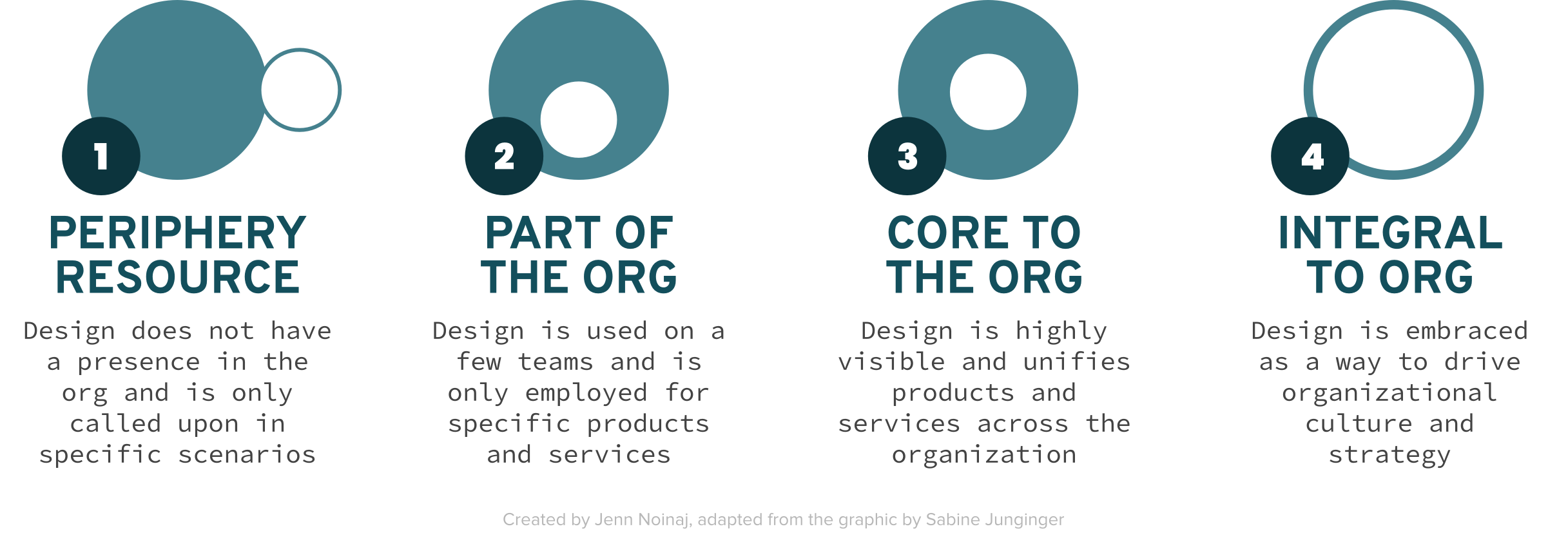In my previous article, I made the case for human-centered design in government. There are pockets of human-centered  design happening throughout the government but, on the whole, the maturity of design as a discipline in government is still ad hoc. Maturing this field within government can improve digital transformation efforts. To understand how, we first have to understand where design sits in the organization. Sabine Junginger’s visual model gives a high-level overview of the four places of design in organizations today.
design happening throughout the government but, on the whole, the maturity of design as a discipline in government is still ad hoc. Maturing this field within government can improve digital transformation efforts. To understand how, we first have to understand where design sits in the organization. Sabine Junginger’s visual model gives a high-level overview of the four places of design in organizations today.

1. Design as a peripheral resource
Design is seen as a specialized discipline that is usually contracted out to an agency or vendor. It is separated from other organizational activities and is often only called upon for specific instances or situations. In these organizations, design is typically being performed at the communication or product level within a limited scope of work.
2. Design as part of the organization
Design is part of one or two organizational functions, such as the communications or engineering team. Activities are limited to designing communications or products, but the organization sees the value of design within the team(s).
3. Design as core to the organization
Design is at the center of the organization, with access to organizational leadership, and is clearly tied to the organization’s strategy. Design unifies the experiences of those who interact with the organization, breaking down silos to create positive interactions. Being human-centered is a mindset that is embraced throughout the organization as part of its culture.
4. Design as integral to the organization
Design is part of the DNA of the organization. Not only is the discipline used to improve communications, products and experiences, but it also shapes workplace culture and employee experiences to completely transform the organization. Design generates a human-centered organizational strategy and is leveraged to understand employee motivations to successfully implement the strategy.
Government has been and is currently undergoing digital transformation and organizational change efforts to deliver services efficiently, cut costs, and improve quality of life. This is often in the form of digitizing processes, simplifying information, and offering multiple touchpoints for the public. Right now, design is either a peripheral resource or part of the organization, but making design integral to government will help accelerate digital transformation and organizational change efforts. These efforts are about the technology as much as they are about the people: the people the organization is serving and the people that are performing the work.
Leaders in government can unlock the barriers that exist with digital transformation in three ways:
- Bring in someone with human-centered design expertise at the CXO level – The quickest way to mature the organization’s capabilities in human-centered design is to invest in the talent and resources at the leadership level.
- Offer human-centered design leadership training and align efforts to performance – Leadership must be aligned on the value of human-centered design and understand it at a high-level so it can be successfully implemented throughout the organization. Tying human-centered design efforts to performance can help cement those changes.
- Create a roadmap to incorporate best practices of design-led organizations – Working up to making design integral to the organization, start by understanding where the organization is and what design activities align with the organization’s strategy. Using a realistic time horizon for the roadmap, map milestones that move the organization through the different maturity stages.
Being aware of these four places can help identify where design is on your teams, departments and organizations, and help to determine what needs to happen to mature design.
Interested in becoming a Featured Contributor? Email topics you’re interested in covering for GovLoop to featuredcontributors@govloop.com. And to read more from our Winter 2021 Cohort, here is a full list of every Featured Contributor during this cohort.
Jenn Noinaj is a social impact strategist, researcher and designer passionate about using design to solve society’s most pressing challenges. She’s currently leading the Public Interest Technology Field Building portfolio at the Beeck Center for Social Impact + Innovation where she works on creating solutions to make the public interest technology field more inclusive. Prior to this role, she worked in the federal government at the US Digital Service where she partnered with various agencies to transform digital services across government, building capacity in technology and design and championing a user-centric culture. You can find more about her on her website and can follow her on LinkedIn and Twitter.





Leave a Reply
You must be logged in to post a comment.